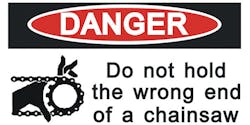The mechanical trades encompass some of the most physically demanding jobs there are. Plumbers and HVAC journeymen have to deal with very heavy materials and powerful equipment daily. Way back, when cast iron and steel were the norm, they used to say that “there is no light plumbing (or HVAC) work.”
Add in power tools, torches, welders, lifts or other sundry equipment and you have a recipe for serious injury at just about any time. As you all know, our trades can be very unforgiving to someone who doesn’t take the proper precautions when handling both material and equipment.
Workplace safety has moved from almost an afterthought to the forefront of the trades today. Again, in times past, “common sense” and a healthy fear for self-preservation dictated how quickly and how thoroughly new hires learned what and what not to do on the job. It seems as though common sense is not as common as it once was however. What with having to put warning labels on darned near everything, such as the following label:Safety training has become a multibillion dollar industry. Without getting into the socio/political nature of this phenomenon, suffice it to say, if you are in business today, jobsite and shop safety is of paramount concern. Protecting your business from frivolous lawsuits and unnecessary downtime while keeping your people safe can be challenging in our litigious society. The bottom line is that you have to take safety very seriously.
Having a company handbook that puts your job requirements in writing offers some protection, but that’s just the beginning. Requiring your field personnel to wear hard hats is a no brainer, but wearing gloves and sturdy work boots is a little more problematic. How do you enforce such requirements? You can provide your people with work gloves, but you can’t be there every minute to see if they wear them. Eye protection is another issue. You can dispense safety glasses, but you can’t be sure that your people are wearing them when they should be. You can be absolutely sure that if an accident happens the employee will want to find someone to blame, regardless of where the fault lies. Guess who?
The inception of Occupational Safety and Health Administration (OSHA) in April of 1971 brought a new dimension to workplace safety. OSHA inspections became the bane of the trades very quickly. Not because its mandate was not a good idea, but because of how it was applied in the field. OSHA dictated safety rules on the job that were, many times, out of touch with reality. The ideas sounded good, but in practice they were anything but. The inspectors often took on the persona of a feudal lord (sort of like local building inspectors but with federal authority) and made demands that were not in any book or ordinance but that must be followed or heavy fines ensued. To object and challenge these unreasonable edicts became an exercise in futility. Most contractors, for better or worse, adopted the policy of “go along to get along.”
On the plus side, job safety improved somewhat. It certainly had the effect of educating personnel on the subject of workplace safety. OSHA also now offers classes on workplace safety tailored to the construction trades, www.OSHA.com, which cover all aspects of the trades and industrial work in general. This is a good thing. Any contractor in business today ought to look into enrolling his people in a class or two. At the very least all foremen should take one or more of the classes, just so they can be aware of what to look for, safety wise, on the job. The classes are not free, but the costs are nominal and the information will give you and your people valuable tools to make the job site a safer place.
On the negative side trying to implement OSHA rules, in their entirety, is really not possible. Not if you want to maintain any semblance of productivity. The real problem is governmental bureaucracy. The more OSHA got into their role, the more picayune and convoluted the regulations became. Disregarding practicality and common sense, regulations have evolved to become a costly burden. Violations of even the most ridiculous ones have become expensive. So, what to do?
Contracting today has become a very delicate balancing act. More so than at any time I can remember. In order to maintain profitability, one has to take everything in, weigh the pros and cons and walk a fine line between regulations and practicality. Giving your people the best in safety training and equipment is a good thing. Keeping the jobsite safe, likewise, is a good thing. Protecting your business from the long arm of over-regulation and legal hassles is a must. Welcome to the wonderful world of contracting in the U.S.A. in 2017.
The Brooklyn, N.Y.-born author is a retired third generation master plumber. He founded Sunflower Plumbing & Heating in Shirley, N.Y., in 1975 and A Professional Commercial Plumbing Inc. in Phoenix in 1980. He holds residential, commercial, industrial and solar plumbing licenses and is certified in welding, clean rooms, polypropylene gas fusion and medical gas piping. He can be reached at [email protected].




